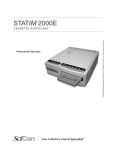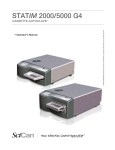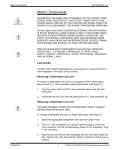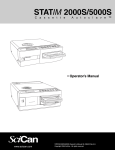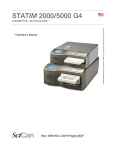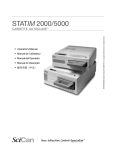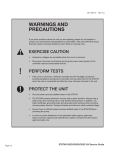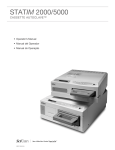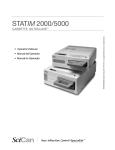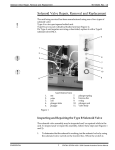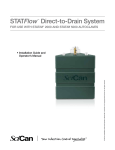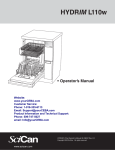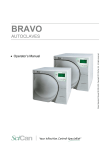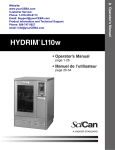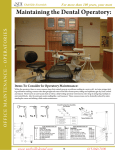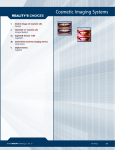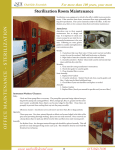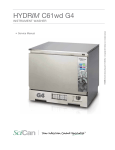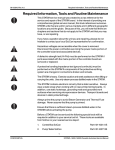Download STATIM 2000E
Transcript
Statim_2000E_manual_rev2_Statim_2000E_manual_rev2 3/10/11 11:23 AM Page 1 STATIM 2000E • Operator’s Manual • Manual del Operador • 用户使用说明 STATIM 2000E Operator’s Manual 95-108628 Rev 4.0. Copyright 2011 SciCan Ltd . All rights reserved CASSETTE AUTOCLAVE ™ Statim_2000E_manual_rev2_Statim_2000E_manual_rev2 3/10/11 11:23 AM Page 1 Table of Contents 1. Introduction . . . . . . . . . . . . . . . . . . . . . . . 2 5. Maintenance . . . . . . . . . . . . . . . . . . . . . 16 2. Important Information . . . . . . . . . . . . . . . 3 5.1 Cleaning the Cassette 5.2 Cleaning the Water Reservoir Filter 5.3 Cleaning the Reservoir 5.4 Cleaning the Exterior Surfaces 5.5 Replacing the Cassette Seal 5.6 Maintaining Fluid Levels 5.7 Reading Water Quality 5.8 Preventative Maintenance Schedule 2.1 Disclaimers 2.2 STATim 2000E – Unit Overview 3. Installation . . . . . . . . . . . . . . . . . . . . . . . . 5 3.1 Environmental Considerations 3.2 Unit Placement 3.3 Connecting the Waste Bottle 3.4 Filling the Reservoir 3.5 Priming the Statim Pump 3.6 Setting the Time and Date 3.7 Language Selection 3.8 Assigning Unit Identifier Number 3.9 Preparing the Unit for Use 3.10 Shipping the Unit 6. Troubleshooting . . . . . . . . . . . . . . . . . . 19 7. Spare Parts List . . . . . . . . . . . . . . . . . . . 22 8. Warranty . . . . . . . . . . . . . . . . . . . . . . . . 23 9. Specifications . . . . . . . . . . . . . . . . . . . . 24 9.1 Specifications 4. Instructions for Use . . . . . . . . . . . . . . . . . 9 4.1 Using the Cassette 4.2 Preparing and Loading Instruments 4.3 Using Biological/Chemical Indicators 4.4 Instrument Weight Table 4.5 Selecting a Cycle 4.6 Operating a Cycle 4.7 Stopping a Cycle EU Representative SciCan GmbH Wangener Straße 78 88299 Leutkirch Germany Tel.: +49 (0)7561 98343 - 0 Fax: +49 (0)7561 98343 - 699 STATIM Cassette Autoclave and Statim are registered trademarks and STAT-DRI and Your Infection Control Specialist are trademarks of SciCan Ltd. All other trademarks referred to in this manual are the property of their respective owners. For all service and repair inquiries: In Canada 1-800-870-7777 United States: 1-800-572-1211 Germany: +49 (0) 7561-98343-620 International: (416) 446-4500 Email: [email protected] SciCan Inc. 701 Technology Drive Canonsburg, PA 15317 USA Phone: +1 724 820 1600 Fax: +1 724 820 1479 Toll free: 1-888-632-6031 Manufactured by: SciCan Ltd. SciCan Medtech Alpenstrasse 166300 Zug SWITZERLAND Phone: +41 (0) 41 727 7027 Fax: +41 (0) 41 727 702 1440 Don Mills Road, Toronto ON M3B 3P9 CANADA Phone: (416) 445-1600 Fax: (416) 445-2727 Toll free: 1-800-667-7733 1 Statim_2000E_manual_rev2_Statim_2000E_manual_rev2 3/10/11 11:23 AM Page 2 1. Introduction Congratulations on your selection of the STATim Cassette Autoclave®. We are confident that you have purchased the finest equipment of its type. The STATim is a compact, counter-top unit that features a number of sterilizing cycles designed to meet your needs and suitability for steam sterilization. The details of installing, operating and servicing your STATim ® are all contained within this operator’s manual. To ensure years of safe, trouble-free service please read these instructions before operating this unit and keep them for future reference. Operational, maintenance and replacement instructions should be followed for the product to perform as designed. Contents of this manual are subject to change without notice to reflect changes and improvements to the Statim product. The STATim 2000E cassette autoclave has been designed expressly for the rapid sterilization of instruments intended for immediate use. This allows you to sterilize instruments between patients. To decrease instrument turn-around time, the STATim 2000E does not have a post-sterilization drying cycle. Quick drying and cooling of the load at the end of the cycle is achieved through evaporation when the cassette is removed and opened immediately following the sterilization cycle. Because of the unique operation of the STATim 2000E, once the instruments are exposed to ambient conditions, their continued sterility cannot be assured. It is recommended to use these instruments immediately after they are comfortable to the touch. The Statim is suitable for the sterilization of dental and medical instruments designed to withstand steam sterilization. The STATim is not designed to sterilize liquids, cloth loads, biomedical waste or materials not compatible with steam sterilization. The processing of such loads may result in incomplete sterilization and / or damage to the autoclave. For more information about instrument suitability for steam sterilization, consult the manufacturers’ reprocessing instructions. 2 Statim_2000E_manual_rev2_Statim_2000E_manual_rev2 3/10/11 11:23 AM Page 3 2. Important Information 2.1 Disclaimers Use only steam-process distilled water in your STATim. Deionized, demineralized, or specially filtered water should not be used. Never use tap water. Do not permit any person other than certified personnel to supply parts for, service or maintain your STATim. SciCan shall not be liable for incidental, special or consequential damages caused by any maintenance or services performed on the STATim by a third party, or for the use of equipment or parts manufactured by a third party, including lost profits, any commercial loss, economic loss, or loss arising from personal injury. Never remove the cover of the unit and never insert objects through holes or openings in the cabinetry. Doing so may damage the unit and / or pose a hazard to the operator. IMPORTANT: Follow local guidelines governing verification of the sterilization procedure. 3 Statim_2000E_manual_rev2_Statim_2000E_manual_rev2 3/10/11 11:23 AM Page 4 2. Important Information 2.2 Unit overview 1 level indicator ■ ■2 keypad 3 reservoir cap/ ■ ■ 5 ■ 6 ■ 7 ■ 8 ■ ■9 10 ■ 4 water filter LCD power indicator active indicator power switch power cable port leveler feet exhaust tube port 3 ■ 4 ■ Figure 1 ■2 ■1 11 ■ 6 ■ ■5 9 ■ 11 cassette ■ The following symbols appear in the margins of this book. A situation which may lead to a mechanical failure. A potential hazard to the operator. UNWRAPPED cycles STOP button Power Indicator LED Important information Caution: Hot Surface and/or Hot Steam The following symbols appear on the unit: START button 7 ■ 8 ■ 10 ■ RUBBER / PLASTIC cycles Caution: Risk of electrical shock. Disconnect supply before servicing Active Indicator LED Caution: Refer to manual for details When you receive your STATim 2000E packing carton, the items listed below will be included. If any of the items are missing, contact your dealer immediately so that the situation can be corrected. Cassette Tray and Lid Power Cord Unwrapped Instrument Rack Operator’s Manual Waste Bottle Exhaust Tube Bottle Lid Fitting Stat-Dri Tube Mounting Hardware 4 Statim_2000E_manual_rev2_Statim_2000E_manual_rev2 3/10/11 11:23 AM Page 5 3. Installation 3.1 Environmental Considerations There are several factors that may affect the performance of your STATim. Please review these factors, and select a suitable location in which to install the unit. • Temperature and Humidity Avoid installing your STATim in direct sunlight or close to a heat source (e.g. vents or radiators). The recommended operating temperatures are 15-25˚C (59˚F to 77˚F) with humidity of 25-70%. • Spacing The vents and openings on the STATim should remain uncovered and unobstructed. Leave a minimum of 50 mm/2˝ between the top, sides and back of the unit and any wall or partition. • Venting The STATim should be operated in a clean, dust free environment. • Work Surface The STATim should be placed on a flat, level, water-resistant surface. Never install and operate the unit on a sloped surface. • Electromagnetic Environment The STATim has been tested and meets applicable standards for electromagnetic emissions. While the unit does not emit any radiation, it may itself be affected by other equipment which does. We recommend that the unit be kept away from potential sources of interference. • Electrical Requirements Use properly grounded and fused power sources with the same voltage rating as indicated on the label at the back of your STATim. Avoid multiple outlet receptacles. If using a surge suppressor power bar, plug in one STATim only. 3.2 Unit Placement When placing the unit on a counter top, ensure the following: • 1 on the front panel should be The level indicator bubble ■ balanced in the front right quadrant of the target. This will ensure that the unit drains properly. Adjusting the three leveler feet will help you move the bubble if necessary. • The unit should be stable and all four feet should be securely in contact with the counter surface. This will prevent the unit from moving freely. 5 ■1 Figure 3 Statim_2000E_manual_rev2_Statim_2000E_manual_rev2 3/10/11 11:23 AM Page 6 3. Installation 3.3 Connecting the Waste Bottle 2 is used to collect the wastewater after it has been converted The waste bottle ■ to steam and then drained from the cassette. To connect the waste bottle to the STATim, follow these steps (see Figure 4): 3 tube into the 1. Insert the exhaust ■ 4 on the back of the unit and fitting ■ connect tightly. ■5 2. Cut the tube to length and slide the waste 5 into place. bottle fitting ■ 3. Place the free end of the tube into the hole in the lid of the waste bottle and hand-tighten the fitting. Do not coil the exhaust tube. 4. Unscrew the lid and copper condenser 6 assembly from the waste bottle. coil ■ The lid and coil should come out together. ■4 ■3 ■6 ■2 5. Fill the waste bottle with water to the MIN line and replace the lid and copper Figure 4 condenser assembly. Empty the waste bottle often to avoid unpleasant odors and discoloration of the contents. (A low-level disinfectant, prepared according to the manufacturer’s instructions, may be added to the waste bottle to remedy this situation). As a minimum, empty the waste bottle each time you refill the reservoir. 6. Place the waste bottle near the unit. Store the bottle below the unit. The tube can be routed through a hole, (8 mm/0.3˝ in diameter) in the counter-top and secured with the provided nylon clamps. 3.4 Filling the STATIM Reservoir When filling the reservoir, ensure you only use steam processed distilled water containing less than 5 ppm total dissolved solids (having conductivity of less than 10 µS / cm). The impurities and additives in other water sources will cause an error reading on the LCD. If you have a water conductivity meter (available from SciCan, order number 01-103139S) check each new water container before filling the reservoir. If your unit is equipped with a Rev 7 PCB or higher (software SxxxR6xx), you can read the water conductivity by refering to Section 5.9 Reading Water Quality. 6 Statim_2000E_manual_rev2_Statim_2000E_manual_rev2 3/10/11 11:23 AM Page 7 3. Installation To fill the reservoir, follow these steps (see Figure 5): ■2 2 1. Remove the reservoir cap ■ 2. Pour steam-process distilled water into the reservoir until almost full (a maximum of 4L/1 U.S. gal). Use a funnel to avoid spillage. 3. Replace and secure the cap. Figure 5 3.5 Priming the STATIM Pump To prime the STATim pump, follow these steps (see Figure 6): 1. Move the unit to the edge of the work surface. The front leveler feet should be approximately 12 mm/0.5˝ from the edge. 3 from 2. Lift the front left corner of the unit upward and remove the drain tube ■ the clip located on the underside of the unit. 3. Pull the drain tube outward so the free end can be positioned over a water container. 4. Fill the reservoir with steam-process distilled water. 4 from the end of the drain tube and allow water to drain from the 5. Remove the plug ■ tube into a container for 30 seconds. When the ■4 water flows in a steady stream, replace the stopper. 6. Lift the front left corner of the unit upward and reinsert the tube into the clip on the underside of the unit. Push the excess length of tubing back into the space provided. ■3 Figure 6 Make sure the plug in the drain tube is secured. After installation, and before sterilizing any instruments, run two RUBBER / PLASTIC cycles. For further instructions, see Section 3.9 Preparing the Unit for Use. 3.6 Setting the Time and Date To set the time and date, follow these steps and watch the blinking cursor on the LCD: 1. Power the STATim OFF. 2. Power up unit while pressing the STOP button to access the User Setup menu. 18:00 HH:MM 20/09/2005 DD/MM/YYYY Display when setting the Date / Time 3. Use the UNWRAPPED cycle button to scroll to TIME/DATE setup and press the RUBBER / PLASTIC cycle button to select it. 4. Use the cycle buttons to select and change the selected field’s value. To increase a field’s value, press the UNWRAPPED cycle button. Hold the button down to increase the value. 7 Statim_2000E_manual_rev2_Statim_2000E_manual_rev2 3/10/11 11:23 AM Page 8 3. Installation 5. To select the next field, press the RUBBER / PLASTIC cycle button. 6. To save changes and return to the regular operating mode, press the STOP button. 7. To quit without making changes, power the STATim OFF. 3.7 Language Selection The messages displayed on the LCD can be changed to a number of different languages. To change the current language selections, follow these steps: 1. Turn the power switch at the back of the unit OFF. N.A. ENGLISH 2. Power up unit while pressing the STOP button to access the User Setup menu. 3. Use the UNWRAPPED cycle button to scroll Display when scrolling through languages to LANGUAGE setup and press the RUBBER / PLASTIC cycle button to select it. 4. Press the UNWRAPPED cycle button to scroll to the next language selection. 5. When the desired language is displayed, press the STOP button to save the selection and return to the regular operating mode. 3.8 Assigning Unit Identifier Number STATIM 2000E S2S2R601 1. Power the STATim OFF. #323 2. Power up unit while pressing the STOP button to access the User Setup menu. Display when assigning unit number 3. Use the UNWRAPPED cycle button to scroll to ID SETUP setup and press the RUBBER / PLASTIC cycle button to select it. 4. Using the cycle buttons, select a maximum of 3 digits to be used as the unit’s identifier. The UNWRAPPED button will increase the selected value. Use the RUBBER / PLASTIC to move to the next digit. 5. To save changes and return to the regular operating mode, press the STOP button. 3.9 Preparing Unit for Use Once the unit is installed and before any instruments are sterilized, run two RUBBER / PLASTIC cycles (see Section 4.6 Operating a Cycle). Remove the cassette once it has cooled. Clean the top (lid) and bottom (tray) sections using a soft cloth to wipe the inside surfaces and then rinse thoroughly with tap water. Once the cassette is clean and dry, coat the inside surfaces with STAT-DRI. 3.10 Shipping the Unit Before you move the unit, you will need to drain the reservoir. To do so, follow these steps: 1. Place a water container below the unit. 2. Using the drain tube (see Section 3.5 Priming the STATim Pump, Figure 6) empty the contents of the reservoir into the water container. 3. Remove any remaining water from the reservoir with a non-linting, absorbant towel. 4. Screw-in the three leveler feet found underneath the unit. 5. Repack the unit in the original packing materials and include all accessories originally included with the unit. 6. Specify heated and insured shipping. 8 Statim_2000E_manual_rev2_Statim_2000E_manual_rev2 3/10/11 11:23 AM Page 9 4. Instructions For Use 4.1 Using the Cassette When removing the cassette after a cycle, exercise caution as the metal areas will be hot and the cassette may contain hot steam. • To open the cassette: 1. Hold the cassette handle with your thumbs facing inward on the cassette latch. 2. Push downward on the cassette latch. cassette latch 3. Raise the cassette lid upwards and disengage the hinge. 4. Rest the lid on its outer surface. • To close the cassette: 1. Align the hinge tab on the cassette lid with the hinge slot on the rear of the bottom tray. Figure 7 2. As you begin to close the lid, the hinge tab and slot will engage. • Inserting the cassette into the STATIM 2000E: 1. Place the end of the cassette into the unit. 2. Gently push inward until you hear a “click” sound. Never push the cassette into the STATim with force as the interior components could be damaged. • Removing the cassette: 1. Grasp the handle with two hands and pull away from the unit. 2. Pull the cassette clear of the unit and set down on a firm surface. • Disengaging the cassette When not in use, the cassette should be disengaged. To disengage the cassette, grasp the handle and pull the cassette out until there is a 15 mm to 20 mm (1/2 to 3/4") gap between the front of the STATim 2000E and the cassette handle. • STAT-DRI Treatment of the interior surfaces of the cassette with the STAT-DRI drying agent, provided with your unit, will minimize spotting. The water in contact with the hot cassette surfaces also evaporates much more efficiently. (Replacement bottles are available from SciCan, order number 2OZPLUS, 8OZPLUST, 32OZPLUS). 9 Statim_2000E_manual_rev2_Statim_2000E_manual_rev2 3/10/11 11:23 AM Page 10 4. Instructions For Use 4.2 Preparing and Loading Instruments Before loading any instruments into the STATim, consult the manufacturer’s reprocessing instructions. • Clean Instruments Clean and rinse all instruments before loading them into the cassette. Disinfectant residues and solid debris may inhibit sterilization and damage the instruments, the cassette, and the STATim. Lubricated instruments must be wiped thoroughly and any excess lubricant should be removed before loading. • Unwrapped Instruments Arrange unwrapped instruments on the instrument rack in the tray so that they do not touch one another. This ensures that steam reaches all surfaces. Instruments must not be stacked or piled in the cassettes. • Rubber and Plastic Instruments The following materials can be sterilized in the STATim: Nylon, polycarbonate (Lexan™), polypropylene, PTFE (Teflon™), acetal (Delrin™), polysulfone (Udel™), polyetherimide (Ultem™), silicone rubber, and polyester. When loading rubber and plastic instruments in the tray, leave a space between the instruments and the cassette walls. This ensures that steam reaches all surfaces. The following materials cannot be sterilized in the STATim: Polyethylene, ABS, styrene, cellulosics, PVC, Acrylic (Plexiglas™), PPO (Noryl™), latex, neoprene, and similar materials. Use of these materials may lead to instrument or equipment damage. If you are unsure of your instrument’s material or construction, do not load into your STATim until you have checked with the instrument manufacturer. • All Instruments The STATim is NOT intended for sterilizing textiles, liquids or biomedical waste. Instruments will remain sterile after a successful cycle until the cassette is disengaged from the unit. Unwrapped instruments, once exposed to ambient or external conditions, cannot be maintained in a sterile state. SciCan recommends the final user carefully choose the most appropriate sterilization cycle according to the recommendations of their leading infection control authorities and local regulatory guidelines / recommendations. • Routine Monitoring Chemical process indicators suitable for steam sterilizers should be included in or on each package or load being sterilized. In addition, the weekly use of biological indicators, which allow you to ascertain whether the instruments have been exposed to sterilization conditions, is recommended. 10 Statim_2000E_manual_rev2_Statim_2000E_manual_rev2 3/10/11 11:23 AM Page 11 4. Instructions For Use 4.3 Using Biological/Chemical Indicators For detailed instructions on how to handle, use and dispose of both the biological and chemical indicators, please consult the product literature accompanying the biological indicators or contact the manufacturer directly. To use the indicators with the STATim, follow these steps: 1. Place the appropriate biological indicator in the STATim chamber. 2. Process the load in the sterilizer according to your usual practice. 3. Ensure that the message “Cycle Complete” is displayed on the LCD after the cycle is finished. 4. Recover the biological and / or chemical indicator and process further according to the literature that accompanied the indicator. At the first indication of a potential sterilization failure: 1. Do not process any more instruments until favourable test results have been returned. 2. Ensure the correct indicator type was chosen. 3. Ensure the cassette was not overloaded. Consult the earlier portion of this section for proper loading instructions. 4. If the results do not change, do not process any more instruments within the STATim and contact your SciCan dealer for further assistance. Because the turnaround time for the biological indicator is up to 48 hours, it is recommended that the tests be conducted so that the incubation period occurs during a period of planned downtime such a the last cycle before a weekend. 11 Statim_2000E_manual_rev2_Statim_2000E_manual_rev2 3/10/11 11:23 AM Page 12 4. Instructions For Use 4.4 Instrument Weight Guide Instrument Typical Instrument Weight Scissors Dental scalers Forceps Dental handpiece Unwrapped instrument rack Suction cannula Plastic mouth mirror Impression tray Plastic x-ray positioning ring 30 g / 0.96 oz 20 g / 0.64 oz 15 g / 0.48 oz 40 to 60 g / 1.29 to 1.92 oz 225 g / 7.23 oz 10 g / 0.32 oz 8 g / 0.25 oz 15 to 45 g / 0.48 to 1.45 oz 20 g / 0.64 oz NOTE: The above weights are to be used as reference only. For exact weights of your instruments, consult the manufacturer’s specifications. 4.5 Selecting a Cycle The STATim 2000E has two sterilization cycles, each designed to sterilize a specific type of instrument. The instruments will remain sterile after a successful cycle until the cassette is removed from the autoclave. Unwrapped instruments, once exposed to ambient or external conditions, cannot be maintained in a sterile state and must be used immediately after they are comfortable to the touch. The types of instruments, sterilization requirements, and a graph depicting each cycle are described over the next few pages. Consult the Instrument Weight Guide in Section 4.4 for information on how to make up an appropriate load for the masses specified for individual cycles. 12 Statim_2000E_manual_rev2_Statim_2000E_manual_rev2 3/10/11 11:23 AM Page 13 4. Instructions For Use 1. Unwrapped Cycle The Unwrapped Cycle is a general purpose sterilization cycle used to sterilize up to 1.0 kg (2.2 lbs) of solid metal instruments such as pliers, burrs, scalers and forceps. Dental handpieces may be sterilized in this cycle. To select the Unwrapped Cycle, press the Unwrapped Cycle button, then press the START button. A D 3.5 MIN.* C B A B Conditioning C Pressurizing E D E F Warming up F Sterilizing Venting Air Drying The sterilization temperature in the cassette is 134 ˚C (273 ˚F) and the holding time is 3.5 minutes. See Section 4.1 Using the Cassette, and Section 4.2 Preparing and Loading Instruments before running this cycle. 2. Rubber and Plastics Cycle The Rubber and Plastics Cycle is used to sterilize up to 0.4 kg (0.9 lbs) of solid unwrapped instruments constructed of metal or the materials listed in Section 4.2 Preparing and Loading Instruments. To select the Rubber and Plastics Cycle, press the Rubber and Plastics Cycle button, then press the START button. B A C A B Conditioning C Pressurizing Warming up D E D E F Sterilizing Venting Air Drying The sterilization temperature in the cassette is 121˚C / 250˚F and the holding time is 15 minutes. 13 F Statim_2000E_manual_rev2_Statim_2000E_manual_rev2 3/10/11 11:23 AM Page 14 4. Instructions For Use 4.6 STATIM 2000E — Operating a Cycle To operate each cycle, follow these steps and watch the LCD: Turn the power switch at the back of the unit to ON. The LCD Display reads: 14:23 3/11/2010 SELECT A CYCLE Press the appropriate cycle button on the keypad. The display will read either: or UNWRAPPED 135˚C for 3.5min. RUBBER AND PLASTICS 121˚C for 15 min. As the button is released the display appears similar to: Cycle you selected PRESS START Press the START button to begin the cycle you selected. The amber indicator light comes on and two lines of messages are alternately displayed at 2 second intervals on the LCD. The top line alternates between the cycle name and the cycle stage in progress. The second line provides temperature readings, pressure values and, during the sterilizing stage, the time remaining in the cycle. Cycle you selected 65˚C WARMING UP CONDITIONING 110˚C PRESSURIZING 125˚C STERILIZING 135˚C 212 kPa 3:30 VENTING 105˚C 14 Statim_2000E_manual_rev2_Statim_2000E_manual_rev2 3/10/11 11:23 AM Page 15 4. Instructions For Use As a cycle is running, you will hear an intermittent buzzing sound as the pump injects water into the steam generator, and a click at random intervals as the exhaust valve opens and closes. If a sterilization cycle is successful, the reminder tone sounds, the amber light flashes and the cycle name is displayed on the top line of the LCD until the operator presses the STOP button or the cassette is removed from the unit. UNWRAPPED CYCLE COMPLETE When removing the cassette be careful. The metal parts will be hot, and the cassette will contain hot steam. After the cassette is removed from the unit, it should be opened to hasten water evaporation from the unwrapped instruments. 4.7 Stopping a Cycle To stop a cycle press the STOP button. If the STOP button is pushed, the cassette is removed, or the unit detects a problem while operating, the cycle will stop and the amber active light will flash. Once a cycle has been stopped, the STOP button must be pressed before another cycle can be started. The display reads any of the following messages: CYCLE FAULT xxx NOT STERILE or CASSETTE REMOVED NOT STERILE If the display shows the message, CYCLE FAULT or NOT STERILE, the cassette contents are not sterile! See Troubleshooting for more information. 15 Statim_2000E_manual_rev2_Statim_2000E_manual_rev2 3/10/11 11:23 AM Page 16 5. Maintenance 5.1 Cleaning the Cassette Keeping the STATim cassette clean is good clinical practice and assists in the function of the unit. SciCan recommends that the interior surface be cleaned at least once a week. Use dishwashing soap or a mild detergent that does not contain chlorine. Scrub the inside of the cassette with a cleaning pad designed for use with Teflon™ coated surfaces. After scouring, rinse thoroughly with water to remove all traces of the detergent. Cleaning the inside of your cassette is very important if you regularly sterilize lubricated instruments. Coating the entire inside surface with STAT-DRI/STAT-DRI PLUS drying agent induces water to form an even coat on the inside surface, without beading. The water in contact with the hot cassette surfaces also evaporates much more efficiently. Spotting is minimized and instruments dry much better. STAT-DRI/ STAT-DRI PLUS should be applied every 10 cycles, and after every cassette cleaning. 5.2 Cleaning the Water Reservoir Filter The water reservoir filter should be cleaned at least once a week or when required. The filter can easily be removed and cleaned by placing the filter upside down under running water to wash away the particles until clean, and then placed back into the reservoir opening. If a replacement water reservoir filter is required, order part number 01-109300S. 5.3 Cleaning the Reservoir Check the reservoir for dirt or particles. The reservoir may be cleaned by draining followed by cleaning and rinsing with steam process distilled water ONLY. Use of chemicals or cleaning agents is not reccommended and could cause the unit damage. 5.4 Cleaning the Exterior Surfaces Use a soft cloth moistened with soap and water to clean all exterior surfaces. Do not use harsh cleaning chemicals or disinfectants. 5.5 Replacing the Cassette Seal To ensure optimum performance of your STATim cassette autoclave, change the cassette seal every 500 cycles or every six months, whichever comes first. Replacement seals are available from SciCan (order number 01-100028S). To change the cassette seal, follow these steps: Place the cassette lid and the new seal on a clean work surface. Examine the position of the old seal in the cassette lid and arrange the new seal in the same orientation, next to the lid. 16 Statim_2000E_manual_rev2_Statim_2000E_manual_rev2 3/10/11 11:23 AM Page 17 5. Maintenance Remove the old seal and discard. Clean any residue out of the seal channel and flush out the channel with distilled water. Lubricate the new seal with the liquid seal lubricant provided. Insert the rounded edge of the seal under the round lip of the lid. Align the holes in the new seal with the holes in the lid. NOTE: At every corner and at the holes in the lid, two square nibs should be visible. The nibs should fit flush with the lid’s outer surface. Ensure the seal is completely inserted. Feel around the periphery to ensure the seal is securely in place. NOTE: During a cycle, steam may appear between the lid and the tray. If this persists, remove the cassette and check that the seal is correctly installed. Figure 13 Be careful. The metal parts will be hot, and the cassette may contain hot steam. 5.6 Maintaining Fluid Levels Use only steam-process distilled water containing less than 5 ppm total dissolved solids (having conductivity of less than 10 µS / cm) in the STATim. To fill the reservoir, remove the cap from the top of the unit and fill the reservoir. We recommend using a funnel to minimize spills. Each time you refill the reservoir, empty the waste bottle and refill with water to the MIN line. Empty the waste bottle often to avoid unpleasant odors and discoloration of the contents. (A low-level chlorine-free disinfectant, prepared according to the manufacturer’s instructions, may be added to the waste bottle to remedy this situation). 5.7 Reading Water Quality (units equipped with Rev7 PCB (software SxxxR6xx) or higher) 1. Power up unit while pressing the STOP button to access the User Setup menu. 2. Using the UNWRAPPED button, scroll to Water Quality and select it by pressing the RUBBER AND PLASTIC button. >Water Quality CD=XXuS l / yyy / z.z ppm CD=conductivity yyy= engineering value 17 XX= micro S. value z.z= parts per million value Statim_2000E_manual_rev2_Statim_2000E_manual_rev2 3/10/11 11:23 AM Page 18 5. Maintenance 5.8 Preventative Maintenance Schedule To ensure trouble-free performance, both the operator and the dealer must follow a preventative maintenance schedule. NOTE: Please refer to your National, Regional, State or Safety laws for any additional reoccurring user testing that may be required. The schedules below describe the necessary actions. Water Reservoir • Replace water as needed. Waste Bottle • Empty the waste bottle every time you refill the water reservoir. • Fill the bottle with water, up to the MIN line marking. You may also add some chlorine-free disinfectant. Cassette • Wash the interior of the cassette with dishwashing soap or a mild detergent that does not contain chlorine. • Scrub the inside with a cleaning pad designed for use with Teflon™-coated surfaces. • After removing all traces of the detergent, treat interior surfaces of the cassette with the STAT-DRI™ Plus drying agent. Order more STAT-DRI™ Plus from your dealer quoting 2OZPLUS, 8OZPLUST, or 32OZPLUS. Water Filter necessary. • Check the water reservoir filter every week and clean if necessary. Replace only if Cassette Seal • Replace every 500 cycles or six months (whichever is first), or whenever necessary. Every 6 months Weekly Daily Operator Once a year Technician Cassette • Check the tray, lid and seal for damage. Replace if necessary. Solenoid Valve • Inspect the valve and clean if dirty. Replace the plunger if defective. Pump • Clean the filters, replace if dirty. Water Reservoir • Check the reservoir for dirt. Clean and rinse with steam process distilled water if necessary. Calibration • Calibrate the unit. 18 Statim_2000E_manual_rev2_Statim_2000E_manual_rev2 3/10/11 11:23 AM Page 19 6. Troubleshooting Problem Solution Unit does not power ON. Check that the unit is plugged into a properly grounded outlet and that the power cord is firmly seated at the rear of the machine. Try another circuit. Power unit OFF for 10 seconds and then power ON again. Check the condition of the line circuit breaker or fuse. There is water under the machine. Check that water has not spilled when refilling the reservoir. Make sure the plug in the exhaust tube is secured. Remove and reinsert the cassette . Attempt another cycle. Be careful. The metal parts will be hot, and the cassette will contain hot steam. The cassette is leaking. If water drips from the underside of the unit during operation, check the cassette seal for misalignment or damage and replace the seal if required. Be careful. The metal parts will be hot, and the cassette will contain hot steam. Attempt another cycle. If it still leaks attempt another cycle using a different cassette if possible. If the leak persists, turn the unit OFF, remove and unload the cassette, unplug the unit, and call your dealer. 19 Statim_2000E_manual_rev2_Statim_2000E_manual_rev2 3/10/11 11:23 AM Page 20 6. Troubleshooting Problem Solution Cycle interrupted — NOT STERILE, Cycle aborted — NOT STERILE and CYCLE FAULT messages. Record the CYCLE FAULT number. Wait a few minutes and attempt another cycle before proceeding to the next solution. Remove the cassette. Be careful. The metal parts will be hot and the cassette will contain hot steam. Inspect the cassette to ensure that the holes in the back of the seal are perfectly aligned, and that the flexible lip of the seal is completely free. Check the exhaust tube for kinks or obstructions. If kinked, straighten the tube. If the tube can not be straightened, remove it from the push-in fitting attached to the STATim. Depress the collar on the fitting and, with the other hand pull firmly on the tube. Once the tube is free of the fitting, cut the damaged section of tubing away using a sharp instrument. Be sure that you leave enough tube to reach the unit when you re-attach the tube to the exhaust fitting. If the tube is too short to remove a section, contact your SciCan dealer for a replacement. Check that the STATim has not inadvertently been exposed to any electrical interference. Refer to the Installation section dealing with Environmental Considerations. (Section 3.1) Try running another cycle. If the problem persists, record the cycle fault message number and contact your dealer. Excessive steam issuing from the front of the machine. Remove and reinsert the cassette. Attempt another cycle. Remove and check the cassette seal for misalignment or damage. Replace the seal if required. Be careful as the metal parts will be hot and the cassette will contain hot steam. If the leak persists, turn the unit OFF, remove and unload the cassette and contact your SciCan dealer. 20 Statim_2000E_manual_rev2_Statim_2000E_manual_rev2 3/10/11 11:23 AM Page 21 6. Troubleshooting Problem Message WATER QUALITY IS NOT ACCEPTABLE. Machine will not start. Solution You have used water which is not steam-process distilled or is improperly distilled. Empty the reservoir and refill with steam-process distilled water containing less than 5 ppm total disolved solids (having conductivity of less than 10 µS / cm). If you have the water conductivity meter, check the quality of the water before refilling the reservoir. Refer to the steps described in Shipping the Unit to empty the reservoir. Message REFILL RESERVOIR, Machine will not start. The level of the water in the reservoir is low. Refill the reservoir. Refer to the steps described in Filling the Reservoir. Time and date are incorrect. The time and date have not been set. See Setting the Time and Date. 21 Statim_2000E_manual_rev2_Statim_2000E_manual_rev2 3/10/11 11:23 AM Page 22 7. Spare Parts List ACCESSORIES 01-100780S Bumper 01-103139S Conductivity Meter 01-100782S Push-in Fitting 01-103923 Condenser Additional Bottle 01-106030S Cassette Lid Handle 01-103945S Rack-Tray Unwrapped Instrument Kit 01-100008A Kit Cassette Final 2OZPLUS STAT-DRI Plus 2 oz. Bottle w/sprayer 01-100028S Cassette Seal 32OZPLUS STAT-DRI Plus 32 oz. Bottle w/sprayer 01-100204S Exhaust Tube 8OZPLUS STAT-DRI Plus 8 oz. Bottle w/cap 01-100271A Kit Tray Cassette w/Mesh, Box Stat1 99-108332 Chemical Emulator 134˚C, 3.5 min. 01-100724S Condenser Bottle w/o Condenser 01-100735S Waste Water Bottle Fitting 01-100612S Tubing & mounting hardware 01-100812S Condenser Bottle 01-100834S Cassette Lid 01-101553S Leveler 01-106653 Mesh Tray 01-108628 Operator’s Manual ST-2000E 01-101647S Power Cord NA 01-101766S Power Cord UK 01-101768S Power Cord Switzerland 01-101769S Power Cord Italy 01-101779S Power Cord Europe 01-101783S Reservoir Cap 01-101787S Water Reservoir Cap and Filter 01-109300S Water Reservoir Filter 01-103475S Tray 01-103865S Seal Lubricant 01-104093S Exhaust Tube 3m Long 01-104343S Plug - Drain Tubing 22 Statim_2000E_manual_rev2_Statim_2000E_manual_rev2 3/10/11 11:23 AM Page 23 8. Warranty Limited Warranty For a period of one year, SciCan guarantees that the STATIM 2000E, when manufactured by SciCan in new and unused condition, will not fail during normal service due to defects in material and workmanship that are not due to apparent abuse, misuse, or accident. The one year warranty will cover the performance of all components of the unit except consumables such as the cassette seal, the compressor filter and the microbiological filter, provided that the product is being used and maintained according to the description in the user’s manual. In the event of failure due to such defects during this period of time, the exclusive remedies shall be repair or replacement, at SciCan’s option and without charge, of any defected part(s) (except gasket), provided SciCan is notified in writing within thirty (30) days of the date of such a failure and further provided that the defective part(s) are returned to SciCan prepaid. This warranty shall be considered to be validated, if the product is accompanied by the original purchase invoice from the authorized SciCan dealer, and such invoice identifies the item by serial number and clearly states the date of purchase. No other validation is acceptable. After one year, all SciCan’s warranties and other duties with respect to the quality of the product shall be conclusively presumed to have been satisfied, all liability therefore shall terminate, and no action or breach of any such warranty or duty may thereafter be commenced against SciCan. Any express warranty not provided hereon and any implied warranty or representation as to performance, and any remedy for breach of contract which, but for this provision, might arise by implication, operation of law, custom of trade or course of dealing , including any implied warranty of merchantability or of fitness for particular purpose with respect to all and any products manufactured by SciCan is excluded and disclaimed by SciCan. If you would like to learn more about SciCan products and features, visit our website at www.scican.com. 23 Statim_2000E_manual_rev2_Statim_2000E_manual_rev2 3/10/11 11:23 AM Page 24 9. Specifications 9.1 STATIM 2000E — Specifications Machine Dimensions: Cassette Size (External): Cassette Size (Internal): Length: 485 mm (19") Width: 415 mm (16.3") Height: 150 mm (5.9") Length: 410 mm (16") includes handles Width: 195 mm (7.67") Height: 40 mm (1.6") Length: 280 mm (11") Width: 180 mm (7.1") Height: 35 mm (1.4") Sterilization Chamber Volume: 1.8 L (61 fl. oz.) U.S. Reservoir Volume: 4.0 L (140 fl. oz.) U.S. Weight (Without water): 21 kg (46 lbs) Clearance required: Top: 50 mm (1.9”) Sides: 50 mm (1.9”) Back: 50 mm (1.9”) Front: 480 mm (18.9”) Maximum Steam Temperature: 138 °C (280 °F) Maximum Operating Pressure: 341 kPa abs (49.5 psia) Electrical Rating* (+ / - 10 %): 110 V, 50 / 60 Hz, 11 A 220-240 V, 50 / 60 Hz, 6 A *see serial number label for requirements specific to your unit. Protection Class: I Protection: covered (indoor use only) Ambient Operating Temperatures and Humidity: 15 °C to 25 °C (59 °F to 77 °F) and 25 % to 70 % Altitude: Up to 2000 meters (6600 ft) Installation Category: 1 24

























